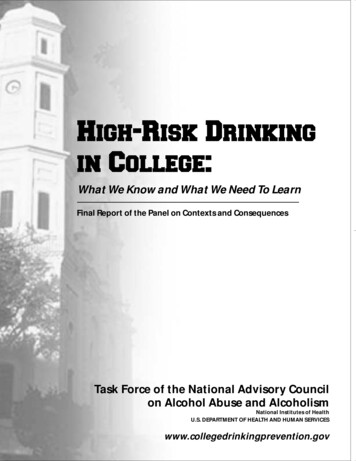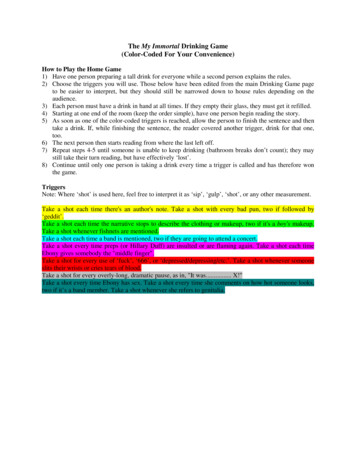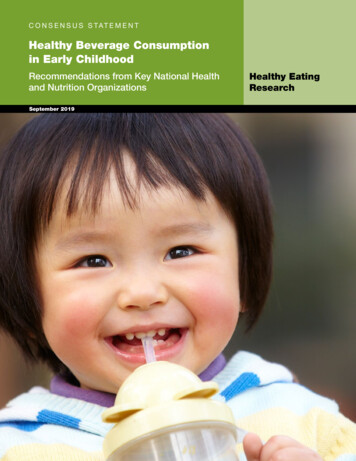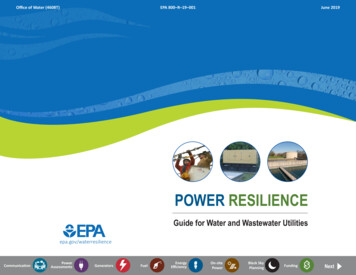
Transcription
High-Risk Drinkingin College:What We Know and What We Need To LearnFinal Report of the Panel on Contexts and ConsequencesTask Force of the National Advisory Councilon Alcohol Abuse and AlcoholismNational Institutes of HealthU.S. DEPARTMENT OF HEALTH AND HUMAN SERVICESwww.collegedrinkingprevention.gov
High-Rissk Drinking in College:High-RiKnoww and What WWee Need To LeaLearrnWhat We KnoFinal Report of the Panel onContexts and ConsConsequencequencequencesesNational Institute on Alcohol Abuse and AlcoholismNational Advisory Council on Alcohol Abuse and AlcoholismTask Force on College DrinkingApril 2002
ContentsEXECUTIVE SUMMARY.vAN ENTRENCHED PROBLEM .vStudent Alcohol Consumption: Multiple Influences .vMultiple Negative Consequences . viiTHE COLLEGE SCENE . viiiRECOMMENDATIONS: STRATEGIES TO REDUCE STUDENT ALCOHOL CONSUMPTION . viiiFor Colleges and Universities .ixFor the Research Community .xFor NIAAA .xiHIGH-RISK DRINKING IN COLLEGE: WHAT WE KNOW AND WHAT WE NEED TO LEARN. 1THE TASK FORCE ON COLLEGE DRINKING . 1THE PANEL ON CONTEXTS AND CONSEQUENCES . 3Overview of College Student Drinking. 5Glossary of Alcohol Terminology . 6Barriers to Reducing Alcohol Misuse . 8EPIDEMIOLOGY OF ALCOHOL USE AMONG COLLEGE STUDENTS . 8Drinking Trends Among College Students .10Strategies for Filling Gaps in Knowledge: Epidemiology of Alcohol Use Among College Students .11SURVEYING THE DAMAGE: CONSEQUENCES OF COLLEGE STUDENT ALCOHOL CONSUMPTION .12Damage to Self .12Damage to Others.13Damage to the Institution.13Alcohol Use and Driving by College Students .14Alcohol and High-Risk Sexual Behavior .14Alcohol and Physical and Sexual Aggression.15Differences in Consequences Among Population Subgroups .16Strategies for Filling Gaps in Knowledge: Consequences of Student Alcohol Consumption.17UNDERSTANDING COLLEGE DRINKING FROM A MULTIDIMENSIONAL PERSPECTIVE .17Developmental Factors .18Individual Student Factors .21Environmental Factors.23Strategies for Filling Gaps in Knowledge: UnderstandingDrinking in College From a Multidimensional Perspective .26ISSUES FOR COLLEGE ADMINISTRATORS .26Issues Related to Federal, State, and Local Laws .27Issues Related to Policy Development .27Issues Related to Policy Enforcement .28Taking Concrete Action To Change the Culture of Drinking on Campus.30Strategies for Filling Gaps in Knowledge: Alcohol-Reduction Efforts .33-iii-
Contents (continued)RESEARCH CONSIDERATIONS .33Exploratory Research .33Descriptive Research .34Explanatory Research.34Evaluation Research .34Issues in Research Design .34Data Collection .35Linking Alcohol Use to Harmful Outcomes.35Strategies for Filling Gaps in Knowledge: Methodology .36SUMMARY AND CONCLUSIONS .36Epidemiology .37Etiology and Context .37Consequences.37Opportunities for Intervention.37REFERENCES .39APPENDIXFIGURES .53List of Exhibits1. The Panel on Contexts and Consequences . 22. Papers Commissioned by the Panel on Contexts and Consequences . 4-iv-
EXECUTIVE SUMMARY“Battle of the Binge: A Fatal Night of Boozing at.”The newspaper headline above is a college administrator’s worst nightmare. Behind its attentiongrabbing words is a major public health problem: excessive use of alcohol by college students. The legaldrinking age in the United States is 21, but heavy drinking by underage college students and by thosewho are age 21 or older is widespread, dangerous, and disruptive. Indeed, U.S. college presidents haveidentified alcohol use as their number one campus-life problem.Excessive drinking among college students is associated with a variety of negative consequences thatinclude fatal and nonfatal injuries; alcohol poisoning; blackouts; academic failure; violence, includingrape and assault; unintended pregnancy; sexually transmitted diseases, including HIV/AIDS; propertydamage; and vocational and criminal consequences that could jeopardize future job prospects.RERENCNCNCHHED PROROBLBLEMAN ENTNTREBLEMAlcohol use on college campuses is not a new problem; it has been documented in the United Statesfor at least 50 years. However, recent concerns have centered on heavy episodic drinking, a potentiallydangerous practice often termed “binge drinking,” and usually defined as consuming five drinks or morein a row for men and four drinks or more in a row for women. According to this definition, about two outof five college students have engaged in binge drinking in the past 2 weeks. An additional two out of fivecollege students drink but not to excess while one in five does not use alcohol at all.In recognition of the serious and sometimes fatal consequences of alcohol consumption amongcollege students, the National Advisory Council on Alcohol Abuse and Alcoholism, National Institutes ofHealth, established two panels of nongovernment experts to help the Institute develop a national researchagenda to better address the problem. The panels included college presidents and administrators, wellknown alcohol researchers, and students. The two panels are Contexts and Consequences (Panel 1) andPrevention and Treatment (Panel 2).This report represents the work of the Panel on Contexts and Consequences and is based on 12commissioned, peer-reviewed papers by experts in the field and extensive discussion among panelmembers and the authors of the papers. It focuses on what is known about drinking in college and itsconsequences and on gaps in knowledge that need further study. The report also places a special emphasison heavy drinking, including binge drinking, because of its potentially serious consequences.Because colleges vary widely in their drinking rates, it would be inaccurate to characterize allcolleges as having an equally urgent drinking problem. But among college students who do drink heavily,the problem is serious: the two out of five students who engage in binge drinking risk a wide range ofalcohol-related consequences, including grave injuries and death.Stuhonsumption:: MuflueencesStuddenentt AlcoAlcohoholl CoConsunsumptionMultipleltiple InInflufluThe Panel found that on many college campuses, heavy drinking is interwoven overtly or subtlythroughout the culture of the institution. As a result, students perceive this drinking pattern as the socialnorm rather than as unhealthy and potentially destructive behavior. Research consistently shows that thereis no one cause of excessive alcohol use by college students, and the Panel thought that it would be naiveand misleading to adopt a simplistic view of, or approach to, this problem.-v-
College student drinking is the product of many factors working together. Among them are: Students’ value systems and personalities; Students’ expectations regarding alcohol’s effects (whether good or bad); Genetic predisposition, often reflected in a family history of alcoholism; Roles and influence of family background and peers; Social integration of drinking into college life; Social context in which drinking takes place (e.g., on- or off-campus parties, on- or off-campus bars); Marketing mechanisms such as reduced-price drink specials and promotional efforts; Economic availability of alcohol, including its retail price and the amount of students’ disposableincome; Legal availability of alcohol; Social and institutional structures, including law enforcement; and Public policy.Developmental processes: Drinking problems among college students are also closely tied todevelopmental processes. Binge drinking rates are lower at younger ages, increase in later adolescence,and drop off in the mid-twenties.The college years are a time of transition, involving challenges and changes in identity, socialrelationships, and living arrangements. However, these transitions also affect noncollege peers,suggesting that what is often interpreted as a campus-based problem may be attributable, in part, to thebroader social and biological processes that characterize late adolescence and early adulthood in general.Factors such as greater personal freedom and independence, greater involvement in social and datingrelationships, and freedom from the responsibilities of marriage and family life appear to be intricatelylinked to greater alcohol involvement.Elevated drinking levels: College drinking occurs at a stage in life when drinking levels aregenerally elevated. The age period from 19 to 24 is associated with the highest prevalence of periodicheavy alcohol consumption during the life span (Johnston et al., 2001b). Although, on average, collegestudents may drink on fewer occasions than their noncollegiate peers, they drink heavily (e.g., five ormore drinks in a sitting) on a more frequent basis than nonstudents, placing them at especially high riskfor the consequences of heavy consumption.Preexisting drinking problems: Because colleges and universities are the social institutions thathelp many youth make the transition from adolescence to adulthood, they often become the playing fieldon which the developmental problems of this life stage, including alcohol misuse, unfold. Panel memberspointed out that the drinking patterns of some college students represent the continuation of behavior thatbegan during high school or even earlier. When these problems emerge at age 18 or 19, they are labeled“college problems,” although they may actually be “high school” or “middle school problems.” Viewedfrom this perspective, while the college experience may serve to “identify” or, in some cases, amplifyexcessive drinking, it does not necessarily cause it.Aspects of campus life supporting drinking: Research does, however, suggest that there are aspectsof certain college environments that may support or facilitate drinking among students. These factors-vi-
include commingling of students under the legal drinking age of 21 with those who can drink legally,substantial amounts of unstructured time, and student-oriented alcohol advertising.College student drinkers: Research shows that: Male college students tend to drink more than female college students; White college students tend to drink more than their African-American and Hispanic peers; Members of fraternities and sororities tend to drink more than students who do not participate in theGreek system; College athletes tend to drink more than peers who are not involved with campus-based sports; and As a group, college students are less likely to use drugs than their noncollege peers.College students vary greatly in their use of alcohol and their beliefs about its positive and negativeeffects. Studies show that two major drinking patterns appear dominant among college students:(1) drinking related to impulsivity, disinhibition, and sensation-seeking; and (2) drinking to managenegative emotional states, such as depression.MulgaConsenceesMulttiple NeNegagattive ConseonseqqueuencncThe negative consequences of excessive drinking can be severe for both those college students whodrink and those around them.Personal consequences: Students who drink heavily may experience a range of personalconsequences that include missing class, academic difficulties, dropping out of school, problems withfriends, health problems, and unprotected or unwanted sex. Excessive use of alcohol can also increase thelikelihood that students will engage in high-risk sex, behave aggressively, or perpetrate or experiencesexual assault. These consequences are highlighted because they can have severe, long-term repercussionsincluding contracting a sexually transmitted disease, becoming pregnant unintentionally, developing anarrest record, or living with the emotional devastation caused by rape.Research clearly demonstrates that heavy alcohol use by college students is associated with high-risksexual behavior. Alcohol impairs information processing and reasoning and heightens the salience ofsimple cues to action (such as sexual arousal) while blunting the more distal consequences of behavior(such as the risk of HIV infection). Students who drink excessively are two to three times more likely tohave had multiple sexual partners in the past month than those who drink responsibly. Similarly, drinkingon a first date is associated with a twofold to threefold increase in the probability of having sex on thatdate.Data also show that alcohol and physical and sexual aggression are linked. Aggressive collegestudents tend to drink more, but it may also be that heavier use increases the likelihood of aggression. Atleast 50 percent of college student sexual assaults are associated with alcohol use. Typically, both partiesin such situations have been drinking when the sexual assault occurs. Alcohol-related sexual assault isunderreported, primarily because of the misplaced shame and stigma that surround this violent andpersonal crime.In addition, approximately one in three 18- to 24-year-olds admitted to emergency rooms for seriousinjuries is intoxicated. Heavy alcohol use is also associated with homicides, suicides, and drownings.-vii-
The link between excessive alcohol consumption and unsafe driving is well known. About one-half ofall fatal traffic crashes among those aged 18 to 24 involve alcohol; many of those killed in this age groupare college students. Alcohol can slow a driver’s reaction time, affect concentration, interfere withsteering, and impair response to pedestrians and traffic signs and signals.Secondhand effects: Noise and property damage, vomit, and unsightly litter are common byproductsof a night of binge drinking on campus. Some researchers term these consequences “secondhand effects,”because they are similar to the secondhand smoke from tobacco use (Wechsler et al., 1998). More thanone-half of college administrators from schools with high levels of excessive drinking report problemswith vandalism and property damage. In addition, students who drink excessively are more likely tophysically or sexually assault other students.OLLEGEGE SCECENNETHE COLLEToday, there is much heterogeneity in college experiences; only about 13 percent of all undergraduatestudents live on campus, and 35 percent are enrolled part-time. Some first-year students who live oncampus may be at particular risk for alcohol misuse. Anecdotal evidence suggests that the first 6 weeks ofenrollment are critical to first-year student success. Because many students initiate heavy drinking duringthese early days of college, the potential exists for excessive alcohol consumption to interfere withsuccessful adaptation to campus life. Unfortunately, many alcohol prevention programs do not target thisearly, critical, high-risk situation.College organizational factors are also related to student drinking. For example, historically Blackcolleges and women’s colleges tend to have lower rates of alcohol use, while colleges with a Greeksystem and colleges that place a heavy emphasis on athletics tend to have higher rates of alcohol use.Commuter colleges and 2-year institutions tend to have lower alcohol consumption rates thannoncommuter schools and 4-year institutions. In terms of size, students at smaller colleges tend to drinkmore than students at larger schools.U.S. laws require that colleges and universities that receive Federal funding develop an alcohol anddrug education policy. In addition to laws, ethical and social obligations dictate that collegeadministrators develop an alcohol policy that is consistent with the institution’s own culture, mission, andvalues. The Panel noted that once drafted and adopted, an institution’s alcohol policy should be respectedand consistently enforced; it should be wholly supported by the college president, students, faculty andstaff, and the neighboring community, including law enforcement officers.Factors that may be external to the campus can also affect college student drinking. For example,alcohol pricing and the density of liquor outlets have been shown to influence consumption by collegestudents. Generally, the lower the price and the higher the concentration of bars and retail outlets nearcampus, the higher the alcohol consumption by college students.ECOMMEOMMENDATIONS: STRATATEGEGEGIEIES TO REDUCE STUDENT ONOn the basis of the research to date, the Panel identified the following strategies as potentiallypromising in reducing excessive drinking among college students.-viii-
FoForr CoandUniveriversitiesCollegeslleges and UniversitiesThe Panel recommends that colleges and universities: Ensure that research related to their own campus and community is developed and used to gainknowledge about the effectiveness of program interventions and the differential vulnerability ofspecific populations on campus. Consider important methodological issues, including sample representativeness, sample size, the useof well-validated measures, and the integrity of data collection efforts when developing databases forassessment, surveillance, and evaluation. Consider the full range and impact of the consequences of heavy drinking, from hangover andmissing class to dropping out, damaging property, and alcohol poisoning. Recognize that a single approach is unlikely to work for everyone on campus. Because there aremultiple reasons for excessive drinking, multiple points of intervention are needed to address them. Recognize that there are transition issues related to entering college, especially during the first fewmonths, that make this a critical time for prevention and intervention activities. Review policy and its implementation continually and update and/or expand it as needed. Involve students in the planning and implementation of interventions; including students often helpsensure the effectiveness of such programs. Consider student motivations for drinking when designing interventions and activities to take itsplace. Review the scope of disciplinary sanctions associated with policy violations for appropriateness andfor consistency of enforcement. Consider carefully a student’s history of alcohol-related infractions to determine appropriate actionwhen alcohol-related incidents occur. A prior history of occurrence indicates the need for a differentlevel of attention than a first occurrence. Possibilities include a full clinical evaluation, referral to asubstance abuse professional, monitoring, and, for those under 21 years of age, parent contact. Recognize that students’ limited experiences with both drinking and sexual activity, together with thefreedom to experiment inherent in the college environment, place them at elevated risk for combiningdrinking and sex in hazardous ways. Given that at least 50 percent of sexual assaults on campus are alcohol-related, become aware of thescope of sexual assault on campus; determine how “victim friendly” college disciplinary proceduresare; and develop opportunities for collaboration between persons responsible for alcohol abuseprevention and those responsible for sexual assault prevention. Consider the potential impact on student alcohol use of faculty’s and other personnel’s consumptionat college or university functions. Consider carefully the potential mixed messages communicated by accepting sponsorships or giftsfrom the alcohol industry.-ix-
Forr the ResReseeararchch CoCommummummunnityFoThe Panel recommends that researchers conduct studies to: Characterize better the extent of clinical-level problems (alcohol abuse and dependence) and alcoholrelated comorbidity in the college population. Understand the relationship between clinical levels of drinking and student consumption indicators(e.g., heavy episodic drinking). Examine the predictive value of college drinking for later alcohol-related problems. Identify the economic consequences of college drinking, including the cost to colleges of damage tothe physical plant. Assess the impact of community pricing policies on drinking among college students. Understand more completely the academic consequences of college drinking, including themechanism(s) through which alcohol may influence academic outcomes. Refine understanding of the heterogeneity of heavy drinking trajectories in adolescence and earlyadulthood, through longitudinal studies, with a particular focus on what factors determine movingfrom a heavy drinking or high episodic drinking pattern to a lower one, and vice versa. Focus on how developmental transitions to college, to work afterward, to a new intimate partner, or toa new friendship can serve as windows of opportunity for effecting change in behavior, includingdrinking. Examine the relationship between the prior drinking histories of incoming students and their use ofalcohol in college and consider what other variables moderate this relationship. Assess whether alcohol use by college students interferes with their social and emotionaldevelopment (both short- and long-term). Assess how institutional consequences (e.g., dismissal or other sanctions) affect drinking behavior. Identify those problem-related, individual-level variables (e.g., drinking motivations) that arepotentially modifiable; use this information to point to opportunities for intervention. Discern how individual-level variables interact with the larger environment to identify possibleenvironmental interventions that might reduce the risk of hazardous drinking for especially vulnerableindividuals. Improve understanding of the association between alcohol consumption and both acute and chronicproblems, recognizing the complexities of the relationships, the influence of other variables at theindividual and situational levels, and bidirectional causation; high-priority research areas include theeffects of alcohol consumption on sexual behavior, sexual assault and other aggression, academicperformance, and compliance with academic norms. Assess more carefully the validity of self-report measures of student alcohol use and explore the useof alternative data collection methods, including observational, archival, and biomedical methods.-x-
For NIAAAThe Panel recommends that NIAAA: Develop, in conjunction with other Federal agencies such as the Center for Substance AbusePrevention, a set of state-of-the-art measures of alcohol use and alcohol consequences, and guidelinesfor sampling, data collection, and data analysis appropriate for assessing college student drinking.These measures could be used by colleges to develop databases for (1) monitoring trends, (2)assessing needs, (3) evaluating natural experiments, (4) evaluating planned interventions, and (5)facilitating multicollege comparisons. Sponsor technical assistance workshops to provide instruction to college researchers andadministrators on the state of the art in research. These workshops should stress the importance ofgathering local data from different types of sources, such as college health departments and localpolice departments. Offer technical assistance to colleges on the implementation of policy and interventions. Establish national targets for the reduction of college drinking rates, and set timelines for thesuccessful accomplishment of these goals.The Panel concluded that intervention strategies based on sound, thoughtfully designed researchstudies are likely to have an effect on reducing excessive and underage alcohol use among collegestudents. The Panel also stressed the need for ongoing evaluation efforts to monitor the interventionsadopted and ensure that they continue to be useful and effective for years to come. Although excessivedrinking on college campuses may seem like entrenched behavior, the Panel agreed that it is potentiallymodifiable with carefully targeted approaches endorsed by all stakeholders including students whotruly value the institution.-xi-
HIGH-RISK DRINKING IN COLLEGE:WHAT WE KNOWAND WWHHAT WE NENEEDED TO LEARLEARNNIn the photos they are both smiling—under the birth and death dates that mark two more collegestudents’ lives cut short by alcohol.Jonathan “Jon” Levy was a popular athlete at Radford University in Virginia who was on track tomake the dean’s list. During his sophomore year, he decided to major in business and join his father’scompany upon graduation. On October 31, 1997 Halloween night after consuming alcohol at a partyon campus, Jon and two other students decided to drive to a fraternity party in a nearby town. On the waythe driver lost control of the car and crashed head-on into oncoming traffic, instantly killing himself, Jonand the driver of the other car (Report of the Attorney General’s Task Force on Drinking by CollegeStudents, 1998).Leslie Baltz was a fourth-year honor student at the University of Virginia (U.Va.), majoring in studioart and art history. She had studied early Italian art in Florence for part of her junior year, and had justbegun work on her senior honors thesis on early American sculpture. On November 29, 1997, Leslie wentto the traditional pre-game parties, where heavy drinking often occurs, before U.Va.’s annual footballgame against Virginia Tech. Leslie, who usually did not drink heavily, did not feel w
dangerous practice often termed "binge drinking," and usually defined as consuming five drinks or more in a row for men and four drinks or more in a row for women. According to this definition, about two out of five college students have engaged in binge drinking in the past 2 weeks. An additional two out of five










